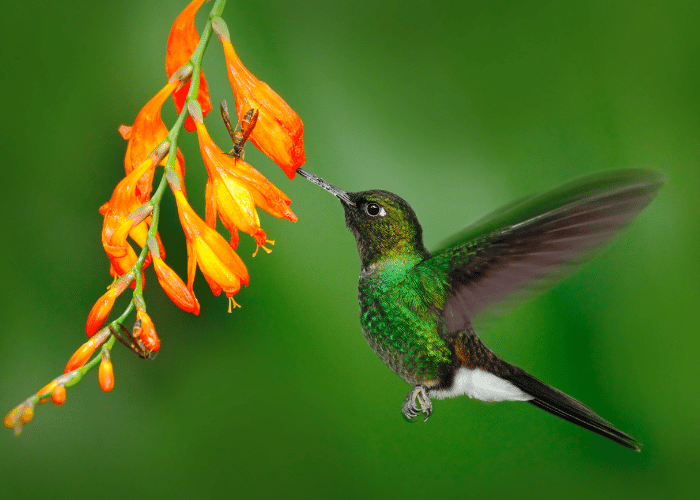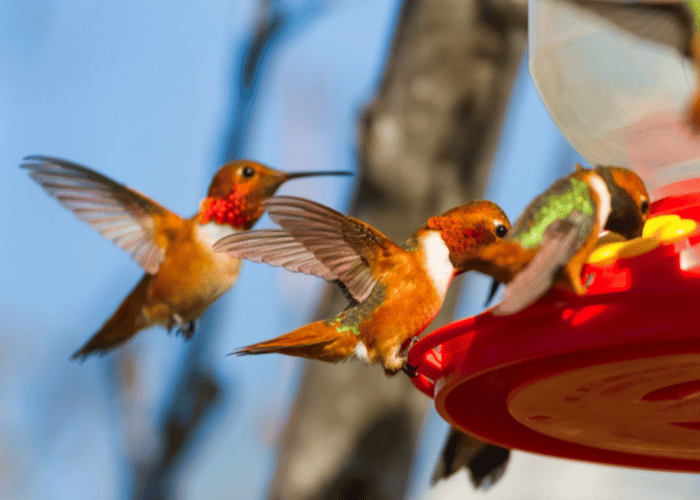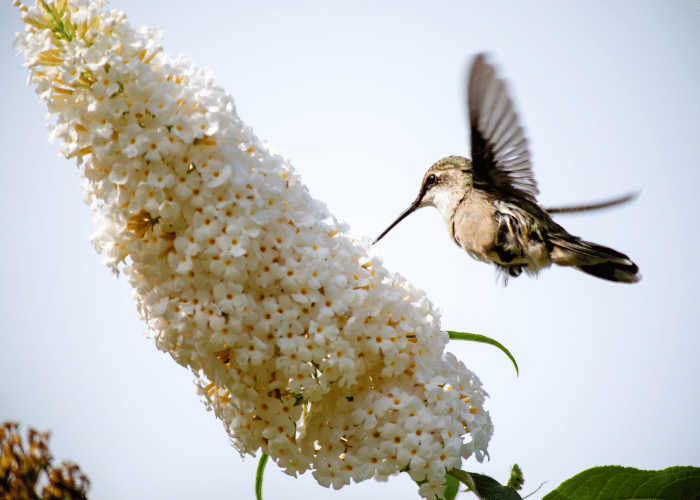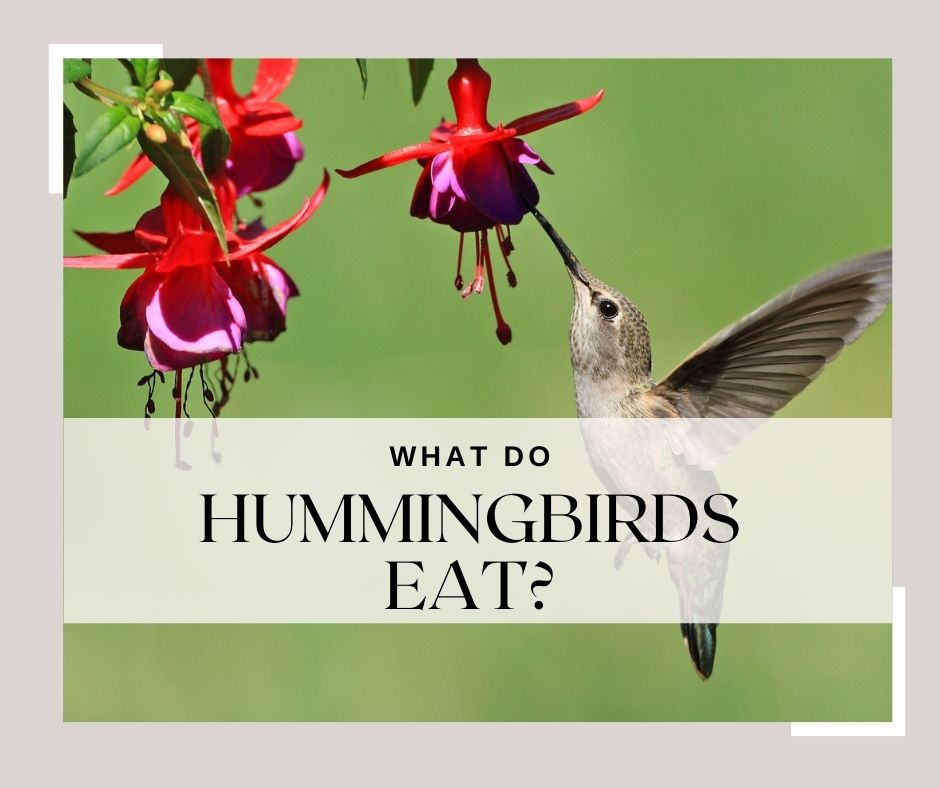What Do Hummingbirds Eat
Table of Contents
If you’ve ever admired the blur of color that is a hummingbird in flight and wondered, “What exactly do these tiny dynamos eat?” You’re not alone. Believe it or not, the diet of these little birds is a hot topic among nature enthusiasts and bird aficionados alike. Let’s delve into the specifics!
Nectar is your hummingbird’s main squeeze. It’s their primary source of energy and sustenance. Hummingbirds have a fancy for flowers and are particularly fond of those offering a sweet treat. Their long, needle-like beaks and even longer tongues are tailor-made to sip nectar deep from the heart of flowers. But that’s not all to their dietary tale!
Here’s a surprise – hummingbirds are also miniature predators! Well, to other tiny creatures like insects and spiders that is. They can’t survive on sweet nectar alone. Protein is another crucial part of their diet, and insects supply that. So, next time you see a hummingbird hovering near a flower, remember, it’s not just a delicate sipper of nectar but also a feisty hunter on the prowl!

Unveiling the Diet: What’s in a Hummingbird’s Menu?
Ready for a dive into the fascinating world of hummingbird diets? The answer to “What do hummingbirds eat?” might surprise you! In short, hummingbirds are high-energy eaters —and they need to be, considering their wings can flap up to 80 times per second. So, let’s take a look at what fuels these miniature avian miracles.
First off, let’s crack the age-old myth. Hummingbirds don’t just live off nectar! While it’s true that they have a sweet tooth, flower nectar only makes up part of their diet.
| Nectar | Insects and spiders |
|---|---|
| 45-55% | 45-55% |
What’s the rest? Well, hummingbirds are pretty adventurous eaters. They gobble up small insects and spiders for a protein fix, ensuring they receive all essential nutrients. They sweep these up during flight or pick through leaves to satisfy their voracious appetite.
Another intriguing titbit about hummingbirds is their love for tree sap. That’s right, an occasional switch from nectar to sap keeps things interesting and tops off the hummingbird menu.
It’s not just what they eat, but how they eat, that’s fascinating. Hummingbirds are equipped with long, needle-like beaks designed perfectly for their feeding routines. These beaks allow them to reach deep into flowers to draw out nectar, ensuring no flower’s hard-to-reach nectar goes untapped.
Here’s a list of their preferred treats:
- Nectar from flowers
- Small insects and spiders
- Tree sap
- Sugar water from feeders
Guaranteeing hummingbirds a balanced diet will attract more of them to your garden and keep the little guys healthy. Embrace the diversity of their diet, and you’re sure to get a front-row seat to some exciting hummingbird action. So, next time you spot one, you’ll know it’s not just sipping nectar but getting a full nutritional meal. You can make your garden a hummingbird hotspot, now that you know what’s in a hummingbird’s menu.
Tiny Birds, Big Appetites: The Caloric Needs of Hummingbirds
You might be thinking, “How much can a hummingbird eat? They’re so tiny!” But, let’s peel back the curtain on a hummingbird’s diet and see what’s really going on. When you consider their high-speed lifestyle, it makes sense that hummingbirds would need a high-energy diet. The fuel for this frenetic activity comes primarily in the form of nectar, a sweet liquid found in certain flowers.
It’s mind-boggling to discover that these miniature avian acrobats consume up to 5 times their body weight in nectar each day. That’s equivalent to a 150 lb human eating a whopping 750 lbs of food daily!
Here’s a fun breakdown for a quick comparison:
| Hummingbirds | Humans | |
|---|---|---|
| Daily Food Intake | 5 times body weight in nectar | Normal caloric intake |
| Caloric Equivalent | Equivalent to 750 lbs for 150 lb human | Normal caloric intake |
But nectar isn’t their only source of nourishment. Insects and spiders make up a vital part of the hummingbird’s diet providing much-needed protein. They especially love:
- Mosquitoes
- Gnats
- Small bees
- Various types of spiders
This protein-packed munch helps them build and repair body tissue. Even the smallest bird species require a comprehensive diet to maintain their health, and hummingbirds are no exception.
Even with these hearty meals, hummingbirds also require an efficient metabolism to maintain their high-energy lifestyle. It’s been observed that these industrious birds have a metabolism roughly 100 times that of an elephant. This ensures that every single drop of nectar and every tiny insect is converted into much-needed energy.
In the end, food is more than just survival for these fascinating creatures. It’s a compelling force behind their extraordinary behaviors and awe-inspiring acrobatics. So next time you spy a hummingbird darting about with seemingly ceaseless energy, you’ll know what keeps them going all day long.
Now you’re clued in on what hummingbirds chomp on! It’s a small peek into the hard work Mother Nature puts into keeping each of her creatures thriving under her care.

Dive into the Sweet Side: Hummingbirds and Nectar
Imagine those tiny, swift creatures, hummingbirds, buzzing around your garden. Their wings a blur of motion as they dart in and out, hovering over flowers. What’s caught their eye – or rather, their beak? It’s nectar! Yes, hummingbirds love nectar, the sweet elixir that flowers offer.
When hummingbirds aren’t racing against the wind, they’re frequenting flowers, indulging in nectar. It’s this flower nectar that provides hummingbirds with an impressive 90% of their diet! Talk about a sweet tooth! It’s rich in sugars, which provide these tiny flyers with the high-energy nutrition they need to keep their wings buzzing.
You might be asking, “How do hummingbirds find nectar?” They’re equipped with a long beak and an even longer tongue that perfectly suit them for this sweet-seeking endeavor. These specially adapted tools allow them to extract nectar from flowers that are off-limits to other birds and insects.
Consider this, hummingbirds can visit up to 2000 flowers in a single day just to quench their intense nectar craving! Now, that’s commitment.
Concerned home bird-watchers often provide feeder solutions meant to replicate flower nectar. But there’s a note of caution there. Pure white table sugar (sucrose) is the safest sweetener to use, as it closely mimics natural flower nectar. Just remember, 1 part sugar to 4 parts water is the ideal mix.
Here’s a helpful ratio chart:
| Sugar (cups) | Water (cups) |
|---|---|
| 1 | 4 |
| 0.5 | 2 |
| 0.25 | 1 |
Avoid honey or artificial sweeteners as they can prove harmful to the tiny creatures. The sugar-water mix doesn’t require any food coloring either; trust me, the hummingbirds will find it just as tastefully enticing.
In the midst of sipping on nectar, hummingbirds also play a crucial role as pollinators. As they flit between flowers, they carry pollen on their beaks and feathers, aiding in the process of fertilization. They’re not just nectar thieves; they’re life-bringers too!
See, every sip these tiny jewels take is filled with purpose — from meeting their high energy needs, to keeping the circle of life going in your garden. Nectar isn’t just food; it’s the lifeblood that keeps the hummingbird world humming!
Bugs on the Fly: Hummingbirds and Insects
Imagine the swift, graceful hum of a hummingbird’s wings. They’re not just masters of the air, but they’re also aces at the dinner table.
Believe it or not, insects make up a significant part of a hummingbird’s diet. Caught mid-flight and snatched from spider webs, these tiny critters are like high-protein snacks for our feathered friends.
Now, you might be wondering what types of insects are on the menu. Well, they’re not picky eaters.
Here are a few bug delicacies that hummingbirds typically feast on:
- Spiders
- Mosquitoes
- Gnats
- Aphids
- Fruit flies
Think of it as a balanced diet. Where the nectar provides the sugars, the insects, on the other hand, offer proteins, fats, and necessary nutrients such as vitamin A.
But don’t get it twisted, the amount of insects a hummingbird eats in a day is nothing short of impressive. On an average day, they might consume up to a 1000 bugs!
Okay, let’s break that down in a digestible format:
| Average Insect Consumption per day |
|---|
| 1000 bugs |
This bug-consumption habit shows us that hummingbirds are not just sugar-loving creatures but are also adaptable predators. They master the art of snapping up insects mid-air or plucking them off leaves and spider webs.
So next time you see a hummingbird zipping around in your backyard, remember, they’re not just there for the flowers. They’re also on the hunt for their next protein-packed meal. After all, even the fastest bird in the sky needs a balanced diet.
Better keep that bug spray to yourself! Even the smallest members of our ecosystem play a major role in keeping it vibrant and diverse. Talk about birds and bugs living in harmony!

The Role of Water in a Hummingbird’s Diet
Pardon the interruption of your day, but it’s high time you knew about the incredible significance of water in a hummingbird’s diet. Water plays a central role in keeping these tiny avian miracles healthy and flying high.
You might wonder, why is water so critical for them? Well, it’s not necessarily about quenching their thirst, though that’s essential, too. The key reason lies in their incredibly high metabolism rates. These small creatures have the highest metabolism of any bird species on the planet!
They feed every 15 to 20 minutes, but that high-octane fuel can’t be processed very well without enough hydration. Providing water helps hummingbirds to digest the huge amounts of nectar, fruit, and insects they consume in a single day.
Water also assists in excreting waste from their systems. Now, that might not sound like a big deal to you, but given the hummingbird’s diet, swiftly eliminating waste is critical for these birds to maintain their absurdly high energy levels.
Did you know that sugar, the primary component of nectar, can ferment if not processed quickly? This isn’t great news for our feathered friends. But with enough water, their systems can process sugar efficiently to prevent fermentation.
Just imagine if you were a hummingbird. You’re sipping nectar from, say, about 1,000 flowers a day. That’s a lot of sugar! So, you’ll need loads of water to aid digestion or you’re going to feel pretty rotten, pretty fast.
- Key Takeaway: Hummingbirds need loads of water for efficient digestion, waste excretion, and preventing sugar fermentation.
Let’s make sure our hummingbird pals don’t go thirsty! They’ve got a lot of flowers to visit. One little act of keeping a clean water source in your garden could make all the difference for them.
Remember, water is vital to hummingbirds, not just as a drink, but as an important part of their dietary process. And that’s why water is so much more than just a thirst quencher for these zippy little wonders. It’s a vital part of their survival strategy.
Wrapping It Up: Understanding Hummingbird Feeding Habits
Well, now you’re practically a hummingbird expert! You’ve mastered the complex diet of these tiny, yet powerful creatures. Let’s crunch some facts and put a bow on our journey into understanding the feeding habits of hummingbirds.
Remember, nectar isn’t just a sweet indulgence for these birds, it’s their main source of energy. In fact, it provides a whopping 90% of their dietary needs. That’s a whole lot of flower hopping and sipping!
But, there’s more to their diet than just nectar. Insects and spiders make up the remaining 10% of their diet and provide an essential source of proteins and nutrients. Don’t be surprised if you spot a hummingbird having a spider snack. They need it for their survival!
While some people think hummingbirds don’t drink water, that’s a misconception. They get their hydration needs mostly from nectar and will occasionally sip water from leaves and other sources. They can even drink raindrops while flying. Isn’t nature amazing?
It’s also worth noting that a certain number of hummingbirds are known to feed their young with a regurgitated mixture of nectar and insects. So it’s safe to say each hummingbird may have its own diet quirks and preferences.
So, here’s a recap:
- Nectar from a variety of flowers: ~90% of diet
- Insects and spiders: ~10% of diet
- Water from various sources: lesser part of their diet, mostly for hydration.
Remember the importance of providing a safe, pesticide-free environment for hummingbirds to feed. They’re not just pretty birds to look at, they play a crucial role in our ecosystem by pollinating flowers. Let’s do our part to help keep these magical creatures thriving!






